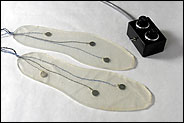|
|
Vibrating Insoles Help People Regain Balance
By Sandra Blakeslee, New York Times
January 17, 2006

How ice ages occur may not seem relevant to people who are terrified of losing their balance and breaking a hip.
But according to scientists who study complex systems, a single principle is involved in climate change, sensing prey in murky water and balance. And, the scientists say, the principle may help prevent falls by the elderly.
The idea is that something nonintuitive occurs when any randomly fluctuating weak signal - the scientific term is "noise" - is fed into any highly variable system like a changing climate or a heavy person tottering on skinny legs. The system is able to detect faint sources of information that lead to greater stability or a new state of order.
For instance, random fluctuations in atmospheric turbulence may push a climate system over the edge to a new cold stability, an ice age. That is called stochastic resonance.
In a study being published in the January issue of The Annals of Neurology, researchers report that vibrating insoles allow diabetics with numb feet and stroke victims with uncertain balance to stand quietly without swaying and losing their balance.
The random vibrations, which were so subtle that people did not have any conscious awareness of them, effectively stimulated the neurons on the bottom of their feet. That provided their wobbly balance system with missing information about how their stance was changing moment to moment.
An earlier study using the vibrating insoles had a similar result, said James J. Collins, a professor of biomedical engineering at Boston University who led the research. In that experiment, the vibrations helped elderly subjects stand as steadily as most 20-year-olds.
John Milton, a neuroscientist at the Claremont Colleges in California and an expert on human movement who is familiar with the research, said it had great potential.
"Anything that decreases the risk of falling even by a few percent will have a tremendous impact on society," Mr. Milton said.
In 2003, more than 1.8 million people 65 and older were treated in emergency departments for fall-related injuries, and more than 421,000 were hospitalized, according to the Centers for Disease Control and Prevention. Such injuries cost more than $20 billion a year.
Human balance relies on pressure and touch signals from nerve cells in the soles of the feet, joints and ankles, Dr. Collins said. While a person stands or moves about in different positions, these signals fluctuate and travel up to the brain, where they combine with vision and sensors in the inner ear to achieve balance.
The body, which is essentially an inverted pendulum, is stabilized by a control loop based on this rapidly changing noise from its periphery.
Unfortunately, as people age the mechanical sensors in their feet, joints and muscles degrade, much as hearing and vision decline, Dr. Collins said. Signals from the feet and lower limbs do not reach the brain to promote balance. People then stiffen their muscles to try to improve stability, and that increases their postural sway.
To deliver more useful noise to the brain, Dr. Collins and his colleagues embedded three battery-powered vibrating elements into insoles made of an elastic silicone gel. When people stand on the insoles, their feet are stimulated by random vibrations that they cannot consciously feel but that nevertheless reach their brains.
In the latest experiments, subjects who had trouble balancing were asked to stand quietly on the insoles, hands at their sides and eyes closed. An overhead camera measured how much their bodies swayed by tracking a marker placed on their shoulders. Subjects with numbness from diabetes and others with damage to the brain from strokes were helped by the vibrating soles.
In 2000, Dr. Collins helped form the Afferent Corporation in Providence, R.I., to commercialize the vibrating insoles for use in ordinary shoes. Prototypes are being developed.
|
|



